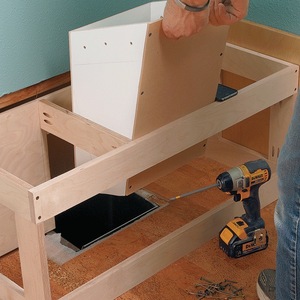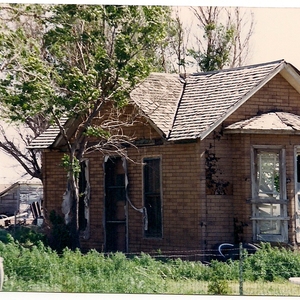We recently purchased a townhouse built in the ’70’s that has aluminum wiring. I would like to update the plug-ins. I cannot find new plug-ins that are aluminum wire compatable. What do I do?
Discussion Forum
Discussion Forum
Up Next
Video Shorts
Featured Story

Fine Homebuilding is excited to be the official media partner of the 2024 Building Science Symposium series! This event offers builders, tradesmen, architects, designers and suppliers to discuss topics ranging…
Highlights
"I have learned so much thanks to the searchable articles on the FHB website. I can confidently say that I expect to be a life-long subscriber." - M.K.

















Replies
Get an electrician to work on it. You aren't likely to find the parts at a home depot etc. This is serious work that should be performed by a professional.
I think the preferred way to replace the outlets is to use copper pigtails with an approved connector and anti-oxidant on the splice.
look at lowes they have al/cu plugs and switches. don't be looking at the 39 cent ones.the al ones run about 2.50 each. how come you want to update them? it would be a good idea to pull each plug ,look at the condition and tighten the screws,but if the plugs are showing no sign of arcing i'd leave them. i have a house with alum. it sucks with no perfect way to fix except pull new wire. larry
hand me the chainsaw, i need to trim the casing just a hair.
The peroblem with the sockets is that some of them are worn out and the plug won't stay in the socket any more. do you know the name of the manufacture of the al/copper sockets? We don't have Lowes stores in British Columbia, Canada. If I knew the name I might be able to find them on the Net. Thanks.
Mine are made by Leviton Mfg. Co. of Little Neck, New York.Good luck with it.George Patterson, Patterson Handyman Service
Here is notice from an insurance company about the different ways of "repairing" AL wiring.http://mb.thehartford.com/insurance_info/pdfs/680-400.pdfBoth Cooper and Levitron make them.http://www.twacomm.com/catalog/model_12650.htm
http://www.acehardware.com/product/index.jsp?productId=1294401&cid=Going to their websites you can get more part numbers and different types of devices..
.
A-holes. Hey every group has to have one. And I have been elected to be the one. I should make that my tagline.
That article appears to cover the situation you heard about fixtures not being compatible with early aluminum wiring. If I read it correctly, a fixture that's marked AL/CU is not compatible with wire made before 1973, but one marked CO/ALR is compatible. Maybe I'm reading too much into it.George Patterson, Patterson Handyman Service
I think that you are right..
.
A-holes. Hey every group has to have one. And I have been elected to be the one. I should make that my tagline.
Thanks everyone for your help with this. Lots of good stuff.
Bigk2
next time i'm at lowes i'll look. if you can't find any i could send you some . larryhand me the chainsaw, i need to trim the casing just a hair.
As I understand it, solid core aluminum conductors are potential hazards in residential construction (mostly 15- and 20-amp circuits). Connecting aluminum to brass screws and lugs may cause arcing/fires because of disimilar metal reactions. Every GFCI manufacturer warns against connecting their product to aluminum conductors. The U.S. Consumer Product Safety Commission suggests that homes wired with aluminum have "55" times of the potential to reach hazard status than homes wired in copper. When you think about COPALUM crimping or other pig-tail methods, think about how you are manipulating the conductors. As an example - bend an aluminum can in half, then back and forth. Doesn't take long to break. How many times must you pull out an outlet/push it in the box, pull out an outlet/push it in the box, etc. Got the concept? Sounds frightening? You bet!
> How many times must you pull out an outlet/push it in the box, pull out an outlet/push it in the box, etc.Once.
So convenient a thing it is to be a reasonable Creature, since it enables one to find or make a Reason for everything one has a mind to do. --Benjamin Franklin
What you want are receptacles and switches marked CO-ALR. The local BB stores have them in this area.
But I just saw a new product announcement.
http://al-copstore.com/index.asp
Don't know anything more about this than what is here.
Seems like a good concept. You can use it to splice AL wires or splice them to a copper pigtail.
.
.
A-holes. Hey every group has to have one. And I have been elected to be the one. I should make that my tagline.
Edited 4/12/2007 7:52 pm by BillHartmann
Yeah, those look reasonable, if the AHJ will accept them.
So convenient a thing it is to be a reasonable Creature, since it enables one to find or make a Reason for everything one has a mind to do. --Benjamin Franklin
bill those look pretty sweet,everything i see i have questioned whether it's better not to just leave the wires alone or try to address them. i can see where that truly separates the alum from the copper but has a good connection point. if you use these sometime give us a report.
they sure don't give much of a quantity break do they?larryhand me the chainsaw, i need to trim the casing just a hair.
> they sure don't give much of a quantity break do they?But three bucks a throw is fairly reasonable, when you compare to labor costs, et al. I do wonder how easy they are to actually deal with, when working deep in a crowded box, and how much extra space they take up. Had to tell about these factors without actually trying them.
So convenient a thing it is to be a reasonable Creature, since it enables one to find or make a Reason for everything one has a mind to do. --Benjamin Franklin
(Shipping is a bit of a rip-off, though)
So convenient a thing it is to be a reasonable Creature, since it enables one to find or make a Reason for everything one has a mind to do. --Benjamin Franklin
I have not personally run into any AL wiring so the odds are low that I will have need for them, but you never know.One of the problems with AL is the difference in expansion between that and the terminals. And that over the years they work loose and start getting high resistance connections which increase the oxidation and the rate of expansion.Supposity the CO-ALR devices are suppose to solve that, but I think that I have heard that it is only valid with used with new alloy that is different than what was used back in the 70's, but I am not sure.But I would lean towards using the splices and replacing the devices..
.
A-holes. Hey every group has to have one. And I have been elected to be the one. I should make that my tagline.
> Supposity the CO-ALR devices are suppose to solve that, but I think
> that I have heard that it is only valid with used with new alloy that
> is different than what was used back in the 70's, but I am not sure.That would make them pretty useless, since nobody's put aluminum circuits in houses since then. You can still use it for large stuff, like service cables, but not lighting or small appliance circuits.George Patterson, Patterson Handyman Service
Except by local amendment you can still use AL for common 15 and 20 amp branch circuits.But I have never seen any wire.And I said that I only "heard" that it was not qualified for use with the older wire..
.
A-holes. Hey every group has to have one. And I have been elected to be the one. I should make that my tagline.
There are some things that ought to immediately reduce the value of a property to that of "undeveloped value minus demolition costs." Aluminum wiring is one such item. The use of various wire nuts and connectors is a matter of great debate withing the electrical community. Even given appropriate devices, other issues have arisen from aluminum- wired homes. The IAEI, an Inspectors' association, used to spend pages every month, detailing problems associated with it. That's why the alloy was changed, and the wire is no longer made in sizes smaller then #6. During the property buying mania of a few years ago, I saw "Flipper" after flipper buy, re-paint, and sell property after property that really needed a bulldozer repair. Now, the bubble has burst, and the losers are stuck with these albatrosses. I forecast a sharp rise in fire losses before this decade is out. Sad to say, but the only true 'fix' for aluminum wiring is a complete gut and re-wire. With a job of that scale, you can be sure that many other, newer code requirements will come into play. On the 'plus' side, this will be your opportunity to adjust the floor plan, update other utilities, and improve the insulation. The end result will be an eye-opener ... a place much better for living. Just count on it taking a long time for it to be reflected in the value of the home.
You'll get a dozen conflicting answers on this. Best solution, short of replacing the wiring, is generally to "pigtail" the individual wires somehow, but there are arguments as to whether it's sufficient to pigtail with NoOx and wire nuts or instead you need one of the proprietary crimp systems (that only a few electricians are franchi$ed to use).
One thing you need to do is to check what your local AHJ will accept.
Here's some interesting reading.
http://www.inspect-ny.com/aluminum/alreduce.htm#1C
I had used a combination of the co/alr devices and pigtails for junctions or where I couldn't find a co/alr device (such as 4-way switches). One other thing to be careful of is nicking the wire with the strippper when stripping the insulation. Even a relatively small nick can cause the wire to partially break. I ultimately carved my walls open and replaced the aluminum with copper.
In this area (central NJ), Home Depot has the fixtures; Lowes does not. Look for Al/Co on the strap. A duplex outlet costs about 3 times what a copper-only outlet costs. You will not find circuit breakers, GFCI outlets, 4-way switches, or light fixtures that are designed for aluminum wiring. If you need to hook one of these up, connect it to a short piece of copper wire (this is called "pigtailing") and connect the copper to the aluminum wire with the special wire nut that's designed for this job. These are purple and cost about $1 each. Due to the amount of extra space this sort of thing takes in boxes, some wiring may have to be completely replaced with copper back to the nearest junction box with enough room.
If you aren't sure you can do the job properly, hire an electrician. That's no joke.
George Patterson, Patterson Handyman Service
I'd splice in copper pig-tails, using Noalox or Penetrox. Thoroughly coat the bare metal in your splices. Twist the splices with your Kleins before you Marrete them. The anti-oxidant will prevent the copper & aluminum from galling, and cold-flow in aluminum is more of a problem under terminals than it is in splices. You can install ordinary switches & receptacles on the copper pigtails.
Also because of cold-flow, tighten all the terminal screws in your panel, because they're probably loose by now. If you're not an electrician, you should hire one for this task.
Never work on live equipment. Always test circuits to ensure they are not energized, and test your tester on a known source after you test the circuit you're working on.
I believe that some cities are allowing pigtails and some are not. Check with your local inspector to find out what they allow.
One thing that DIYs don't consider is that if they do a renovation but do not make it code and there is a problem, such as an electrical based fire, if the fire inspector points the cause to the wiring not being code your insurance company may not pay the claim.
"One thing that DIYs don't consider is that if they do a renovation but do not make it code and there is a problem, such as an electrical based fire, if the fire inspector points the cause to the wiring not being code your insurance company may not pay the claim."Find the wording in your insurance policy that says that.I have looked for in mine. I have ask other to look for it and gotten ZIP. And I have gotten responses from people in the insurance business that that say that it is covered. One used the phrase that they "insure against stupidity"..
.
A-holes. Hey every group has to have one. And I have been elected to be the one. I should make that my tagline.
The key words are "may not pay the claim". Meaning that since an insurance company's normal desire is to make money they will look for an out whenever possible.
I am not quoting insurance policy, no more than an insurance agent will know how a claim adjuster will determine the outcome of a claim.
I am merely saying that if a person decides to DIY, please educate yourself as to what is correct and you won't have any possible issues in the future. No one wants a fire caused by negligence.Do everything you do to the very best of your ability, or don't bother doing it at all.